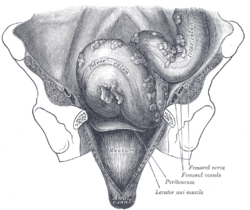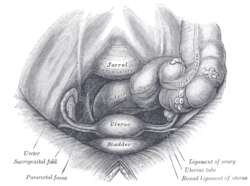结肠带
结肠带(taeniae coli,也作teniae coli或tenia coli)是结肠外壁的三条纵向平滑肌带,对应消化道其他部位的肌外层,为结肠的特化组织,在乙状结肠以前的结肠(升结肠、横结肠、降结肠)均存在。结肠带肉眼可见,位于结肠的最外层(浆膜或纤维膜)之下,可细分为mesocolic、free、omental三条。结肠带的收缩会造成结肠袋的产生。结肠带在阑尾开始处一分为三;在乙状结肠-直肠连接处,三条结肠带则分散开来并合而为一,成为纵向肌肉层。结肠带受副交感神经调控,其神经由脊髓的荐椎部分出。[1]
| 结肠带 | |
|---|---|
 图中大肠中央的纵向带状构造即为结肠带。此图省略了耻骨与膀胱。 | |
 由前上方(anterior superior)观察的女性骨盆腔。图中标示colon即为结肠。 | |
| 标识字符 | |
| 拉丁文 | Taeniae coli |
| TA98 | A05.7.03.013 |
| TA2 | 2993 |
| FMA | FMA:76487 |
| 格雷氏 | p.1186 |
| 《解剖学术语》 [在维基数据上编辑] | |

参考资料
编辑- ^ Lambert, H. Wayne; Wineski, Lawrence E. Anatomy & Embryology. Lippincott Williams & Wilkins. 2011: 65.
Destruction of the sacral spinal cord will eliminate parasympathetic outflow to the hindgut, pelvic organs, and perineum as well as somatic innervation to much of the pelvis and lower limbs. Because it stimulates gut motility and tone, loss of parasympathetic input will result in relaxation and inactivity of the teniæ coli in the descending colon.
外部链接
编辑- Histology image: 12502loa – 波士顿大学的组织学学习系统 - "Digestive System: Alimentary Canal: colon, taeniae coli"
- UIUC Histology SubjectUIUC组织学主题 853
- 人体解剖学在线(Human Anatomy Online)网站上的相关图片:39:13-0201 - "Intestines and Pancreas: Large Intestine"
- Anatomy image:8185 at the SUNY Downstate Medical Center
| 这是一篇与解剖学相关的小作品。您可以通过编辑或修订扩充其内容。 |